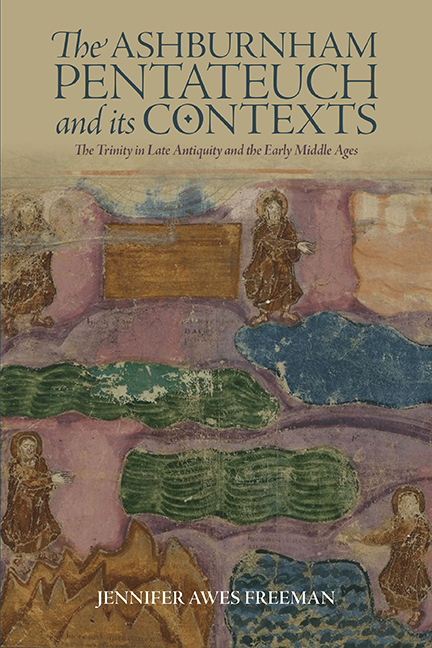Book contents
- Frontmatter
- Dedication
- Contents
- List of Illustrations
- List of Abbreviations
- Introduction: Losing and Finding the Ashburnham Pentateuch
- 1 Early Trinitarian Texts and Debates
- 2 The Trinity in Early Christian Images
- 3 Carolingian Conceptions of the Trinity
- 4 Carolingian Image Theory
- 5 The Carolingian Reception of the Ashburnham Pentateuch
- Conclusion: Possible Motivations for the Ashburnham Pentateuch Erasures
- Coda: The Afterlives of the Ashburnham Pentateuch
- Acknowledgments
- Bibliography
- Index
- ALREADY PUBLISHED
1 - Early Trinitarian Texts and Debates
Published online by Cambridge University Press: 26 May 2022
- Frontmatter
- Dedication
- Contents
- List of Illustrations
- List of Abbreviations
- Introduction: Losing and Finding the Ashburnham Pentateuch
- 1 Early Trinitarian Texts and Debates
- 2 The Trinity in Early Christian Images
- 3 Carolingian Conceptions of the Trinity
- 4 Carolingian Image Theory
- 5 The Carolingian Reception of the Ashburnham Pentateuch
- Conclusion: Possible Motivations for the Ashburnham Pentateuch Erasures
- Coda: The Afterlives of the Ashburnham Pentateuch
- Acknowledgments
- Bibliography
- Index
- ALREADY PUBLISHED
Summary
The Ashburnham Pentateuch writes God in dark, even strokes of the quill – expressed in the swelled bellies of a's and the bowed m's characteristic of uncial script – with earthy, red chapter headings and canon tables. The Ashburnham Pentateuch writes God in Latin; moreover, its particular Latin text makes it one of the oldest extant pre-Carolingian Vulgate manuscripts of Genesis through Numbers. In the Christian tradition, it is a commonplace that before there were human-made visual depictions of God, there were texts describing God. After all, “in the beginning was the word,” as the evangelist John would have it (John 1:1). The history of the relationship between text and image is a complicated one, and although various theologians have attempted to privilege one over the other (more often favoring the word), in reality the two modes of expression have almost always been intertwined in terms of both form and function, and have been mutually, even symbiotically, influential.
In Script as Image, Jeffrey Hamburger explores what he refers to as the “iconicity of script,” that is, the ability of the written text to bear meaning even apart from the content it signifies as an assemblage of letters. In the Middle Ages, the power of the written word extended far beyond its informative and even decorative functions. It could carry a multitude of meanings, simultaneously operating as sign, symbol, and figure. The written word could also elicit visceral performative responses from readers.
Conversely, medieval images were themselves a kind of text to be read, an understanding famously articulated by Pope Gregory the Great in the sixth century, when he wrote, “For a picture is displayed in churches on this account, in order that those who do not know letters may at least read by seeing on the walls what they are unable to read in books.” This statement not only legitimized the use of religious images as “books for the illiterate,” but also reinforced and has since been used to perpetuate a hierarchy in which images are subjugated to words – deriving value from their ability to illustrate the biblical text accurately and effectively.
- Type
- Chapter
- Information
- The Ashburnham Pentateuch and its ContextsThe Trinity in Late Antiquity and the Early Middle Ages, pp. 20 - 33Publisher: Boydell & BrewerPrint publication year: 2022

